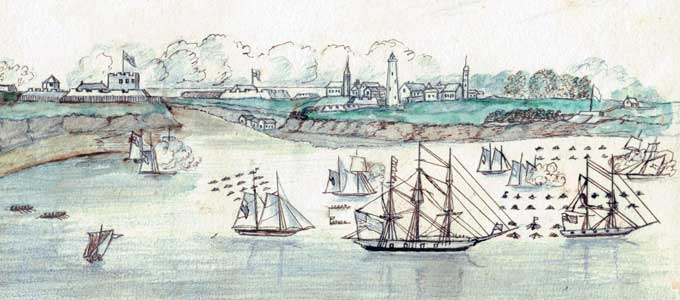
The History of Fort George
After turning over Fort Niagara to the Americans in 1796 in accordance with Jay's Treaty of 1794, the British began construction of a fortification on the west side of the Niagara River to secure their interests in Upper Canada. By 1802, the construction of Fort George was complete. The fort's outer defenses included six large bastions and a palisade wall encircled by a dry ditch. Log blockhouses, kitchens, a hospital, workshops, barracks, officers' quarters and a stone powder magazine were constructed inside the walls.
Standing guard over Navy Hall and transportation along the Niagara River, Fort George served as the headquarters for the Centre Division of the British Army during the War of 1812. Major General Sir Isaac Brock served at Fort George until his death at the Battle of Queenston Heights on October 13, 1812. Brock and his aide-de-camp, Lieutenant Colonel John Macdonell, were interred in the northeast bastion at the fort following the battle. Their remains were later relocated to the first Brock Monument in 1824.
On the morning of May 25, 1813, batteries at Fort Niagara and along the American side of the Niagara River unleashed a devastating artillery bombardment on Fort George. Almost every building within the fort was destroyed. Two days later, a large American invading force landed west of the mouth of the Niagara River. The town of Niagara was turned into a battlefield as the Americans pushed towards Fort George. British and militia forces put up stiff resistance, but were heavily outnumbered. Around noon, the order was given to retreat, and the British retired to Burlington Heights (located in present-day Hamilton, Ontario).
The Americans held onto Fort George for nearly seven months, but failed to maintain a strategic foothold in Upper Canada following their defeats by the British at Stoney Creek and Beaver Dams. By December 1813, the U.S. forces at Fort George had dwindled to a small handful of militia. After a scouting party encountered a large British reconnaissance force, the commanding officer at Fort George (Brigadier-General George McClure of the New York militia) feared an attack was imminent.
On December 10, 1813, McClure ordered a retreat across the Niagara River. In addition, he ordered the destruction of the town of Niagara. When the British arrived, they were met by a horrifying sight. Captain William Hamilton Merritt of the Provincial Dragoons recalled that "nothing but heaps of coals, and the streets full of furniture…met the eye in all directions." About 130 homes had been put to the torch, and some 400 townspeople (mainly women, children and elderly men) were left without shelter.
Fort George remained in British possession for the remainder of the War of 1812. During the American occupation, parts of the fort had been rebuilt. The British continued to rebuild the site following the war, but by the 1820's, Fort George was falling into ruins. The British Army eventually abandoned the fort in favour of Butler's Barracks and Fort Mississauga.
In the 1930's, Fort George was reconstructed to its pre-1812 appearance under the guidance of the Royal Engineers, and designated a National Historic Site of Canada. Today, visitors can tour the blockhouses where common soldiers and their families shared a cramped living space, or the officers' quarters where upper class English officers lived a much more elegant lifestyle. The stone powder magazine, which survived the Battle of Fort George, remains the oldest building in Niagara-on-the-Lake (and the oldest military building in Ontario). These buildings coupled with costumed interpreters and collections of historic artifacts help bring Fort George National Historic Site to life.
Top image courtesy of the Niagara Historical Society and Museum.
